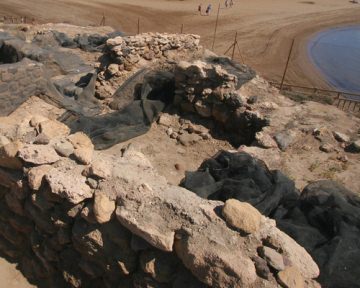Punta de los Gavilanes (Sparrowhawk Point)
Entre la playa de La Reya y playa de La Pava (Entrada por calle Argentina)
30860
PUERTO DE MAZARRÓN (MAZARRÓN)
Telephone: +34 968 594 426
e-mail: turismo@mazarron.es
www.visitamazarron.com
From the first centuries in the 2nd Millennium B.C. to the late 2nd century and beginning of the 1st century B.C.
This small headland separating the beaches of La Reya and La Pava has been inhabited since the most remote of times, from Prehistory to Romanization.
Thus, archaeological excavations need to be extremely careful and methodical when working in the area, which is exactly what a team from the Archeology Department of the University of Murcia is doing within a comprehensive Research Project that includes works in the old settlement of Mazarrón’s coastline.
The settlement was first inhabited during the first centuries of the 2nd millennium B.C. due to the economic diversity of the Argaric groups in the area, who mainly worked in the exploitation of sea resources and supported sea and coastal navigation. Later, in the first millennium B.C. and towards the late 8th century and beginning of the 7th century B.C, the headland was used by Western Phoenicians as a trade point, and that was how things still were during the 6th century B.C. But the discovery of a silver-mining factory that operated during the 4th and 3rd centuries B.C. is perhaps one of the most relevant works currently being developed at the site.
Said factory, whose metallurgical techniques were similar to the ones being performed at the time at Laurion’s Attica mines, is unique in the Western Mediterranean.
The different parts of the building, which give evidence on the type of process followed, are still preserved and show that the metallic lead coming from the foundries near Mazarrón’s mines, was fire assayed in these facilities. This factory stopped being used when Kart Hadast was conquered by Rome in 209 B.C.
However, towards the end of the 2nd century and early 1st century B.C. the place was again occupied, playing a similar role, although not as important as in the past and heavily dependant on the mining activity at Mazarrón under Roman administration.
This activity continued until the change of Era, after which the headland was definitely abandoned and left uninhabited. This abandonment helped significantly to keep the place in good condition and that is exactly why we should protect it for the future.
REMARKS
In excavation process. Temporarily not visible.




